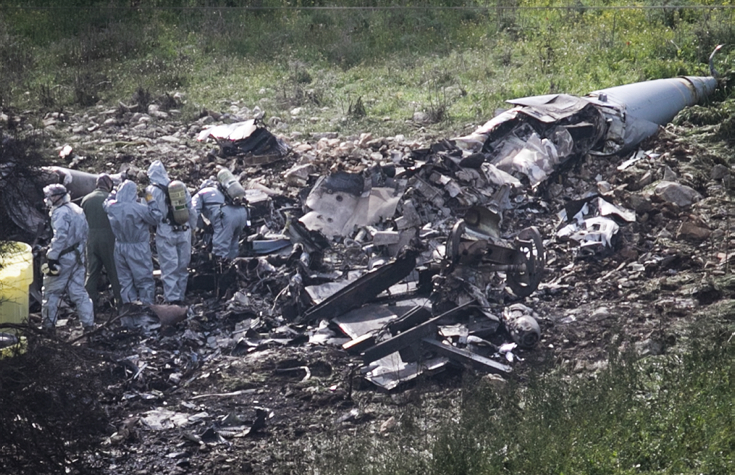The conflict heating up on Israel’s northern border is a direct consequence of the Iran nuclear deal. Dealing with this threat will have to involve rethinking its terms.
Like everything about the Obama administration, the Iran nuclear deal is old news. Carping about the nuclear pact, we are told, like the discussion of everything else about President Obama’s eight years in office, is a waste of time. With his successor providing fodder for his critics on a daily basis and the world facing a host of new challenges, most observers believe that what happened prior to January 2017 is now the business of historians and no one else.
But the thing about history is that choices made in the past have an inevitable way of influencing the present. That’s why what happened over the skies of northern Israel this past weekend can’t be understood without placing it in the context of recent history.
The Iranian drone that crossed into Israeli airspace and the subsequent battles that included the shooting down of an Israeli Air Force F-16 jet weren’t random events without any connection to the Obama administration’s choices on Iran. By choosing to normalize relations with Tehran—and signing a deal that legalized their nuclear program and ignored everything else it was doing—the United States set in motion a series of events that led directly to the presence of significant Iranian forces in Syria that had no compunction about challenging the Israeli Defense Forces.
To note this, of course, is not to ignore other factors, such as the decision of the Bush administration to invade Iraq, which toppled one anti-Israel dictator who was a threat to the region but had the unintended consequence of strengthening Iran.
Yet there’s no question that President Obama’s belief that allowing Iran to “get right with the world” would change the Middle East for the better was a tragic mistake. Far from encouraging Iran to be a responsible member of the world community, ending sanctions encouraged its leaders to treat the deal as a green light for their quest for regional hegemony.
Even if all this is true, considering that Russia and China and America’s European allies don’t want a renegotiation, isn’t complaining about the nuclear deal a pointless exercise?
No. If the current mess in Syria is to be resolved—rather than merely tolerated as we wait for the inevitable moment when it explodes into a full-scale war that must be prevented—then diplomats are going to have do more than just implement an uncertain cease-fire.
The only solution is going to have to involve rolling back the gains Iran has made since President Obama and Secretary of State John Kerry bowed to Tehran’s demands and signed a deal that set them on their current path. Far from the continuing discussion about the subject being a case of President Trump and his supporters holding grudges about Obama, the West needs to realize that the price of the bad deal they struck is going to continue to increase if they don’t act now.
Obama’s mistake was not merely agreeing to abandon all of the West’s demands on the nuclear issue and give Iran a deal that allows it to keep its program, and eventually, once the deal expires within a decade, to develop a bomb anyway. It’s that he made foreign-policy decisions on other issues with an eye towards not offending the Iranians during the negotiations.
Though we didn’t know it at the time, Obama’s astonishing decision to back away from his “red line” warning to Syrian dictator Bashar Assad’s use of chemical weapons on his own people was linked to his hopes for a deal with Iran. American action in Syria that would have punished Assad for his atrocities would have also offended Assad’s Iranian allies. Punting responsibility for what was happening in Syria to Russia opened the door for Moscow to assert its dominance in the region and at the same time allowed Iranian intervention there in order to keep Assad in power.
That leaves Trump with a dilemma in which his desire for better relations with Russia is complicated by America’s need to restrain an Iranian regime that’s causing trouble all over the region. If Trump continues to treat the conflict with ISIS as the only U.S. responsibility in the Middle East, it leaves Israel on its own to confront a situation in the north in which it faces Russia, Syria, Iran and Hezbollah. Given Russia’s strength and Trump’s seeming unwillingness to try and reverse Obama’s surrender, right now it looks like the Israelis will have little choice but to learn to live with an even more perilous situation. The same will be true for the Saudis and other U.S. Arab allies Trump values.
But simply sitting back and allowing Iran enjoy the power that the nuclear pact gave it is incompatible with the Trump foreign-policy speech he delivered in December that made it clear that the United States wouldn’t abandon its friends in this manner.
The first step back from the hole America dug for itself is to insist that the nuclear deal be renegotiated, both in terms of its sunset clauses and the need to restrain Iran’s foreign adventurism. It’ll be a tough sell. But Trump needs to make it clear to President Putin that the Iranian tiger he and Obama unleashed won’t leave Russian policy unscathed as Moscow seeks to maintain its increased influence in the region. If it chooses, the United States has the power, via its own sanctions, to penalize any other country in the world that does business with Iran. Whether or not Moscow or Europe likes it, America can isolate Iran again if Trump and Congress have the will to do so.
Obama’s decisions made the current danger inevitable. Reversing the situation is the only way to impress upon Iran that it must begin retreating from a path to war. The alternative is a surrender that will only lead to more bloodshed. Yes, the cost of nuclear folly is going up. But in the absence of U.S. action, the bill won’t be paid by Israel alone.

























